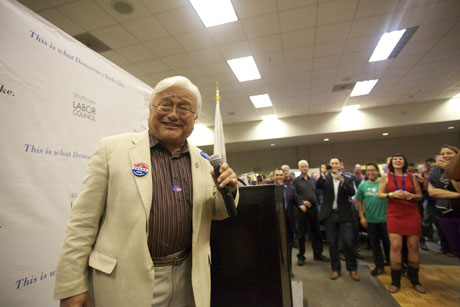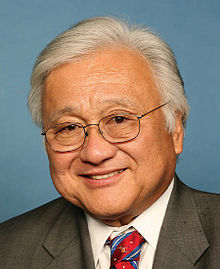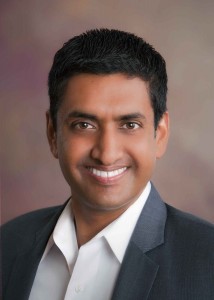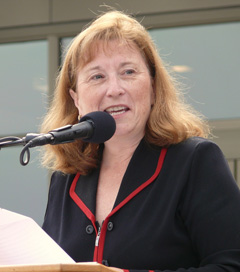 I like Ro Khanna, but I’m still backing Mike Honda
I like Ro Khanna, but I’m still backing Mike Honda
Of the three Congressional races in Alameda county, only one, so far, is worthy of attention: the one between Ro Khanna and Mike Honda for CD 17. No serious candidate is likely to challenge Barbara Lee for CD 13, and while Ellen Corbett is challenging Eric Swalwell in CD 15, she’s doing it so quietly that every time I see her I feel like asking her whether she’s still running.
Honda and Khanna, on the other hand, have both taken onto the campaign trail with gusto. They are active in social media, they issue press releases and stage press events right and left. Honda is meeting with constituents while Khanna has his coffees, walks and other events. Indeed, it’d be easy to get campaign exhaustion by just reading about all their doings.
In past elections, such flurry of activity by a challenger might have gone unnoticed, such is the power of incumbency. But Pete Stark‘s defeat by newcomer Eric Swalwell after California switched to a top-two open primary system, has put the fear of the election gods in the hearts of incumbents throughout the state. And while Mike Honda is a popular politician with a solid record who shouldn’t have to worry even today – Ro Khanna is young, has energy, the Obama campaign team, almost two million dollars in the bank and seemingly the ability to raise even more astonishing amounts of money. So Honda is nervous.
His nervousness was clear last week when he challenged Khanna to support an expansion of social security. Khanna quickly countered that he supports raising the limit on salary contributions to make social security solid, before talking about expansion. With the two in the same corner, the issue fizzled out.
This week, Honda got the endorsement of MoveOn. Given that it comes about 8 months too early, I can only imagine that it’s another sign that Honda is nervous and he wants something, anything, to mobilize his supporters and, more importantly, his contributors. Indeed, he quickly sent an e-mail to supporters announcing the endorsement and asking for money. While Honda has done a reasonable job at fundraising, his base are ordinary folks and unions (during his 2012 campaign, retirees and human rights professionals were among his five top “industry” contributors). Khanna depends greatly on Silicon Valley billionaires. Khanna, meanwhile, is making a point that he is not taking money from PACS – which he can afford to do given how wealthy his private donors are.
The news that 90% of MoveOn members on his district chose to endorse Mike Honda is not particularly noteworthy. Honda is as reliable a progressive vote as you can possibly want in Washington. He may not have been particularly effective, but no progressive has been in the last decade. At least he votes the right way.
 Chances are that Khanna will too. The political philosophy he has espoused has not differed much from Honda’s. Rather than on political differences, Khanna’s campaign will rest on his youth and energy, his yet-to-be-announced fresh ideas, his ability to inspire and motivate people (Khanna has not only won the favor of the Silicon Valley upper crust, he has also been building a very strong grass root movement of people who really believe in him) and his potential of becoming a liberal counterweight to Paul Ryan and even the tea-party ideologues in the Senate.
Chances are that Khanna will too. The political philosophy he has espoused has not differed much from Honda’s. Rather than on political differences, Khanna’s campaign will rest on his youth and energy, his yet-to-be-announced fresh ideas, his ability to inspire and motivate people (Khanna has not only won the favor of the Silicon Valley upper crust, he has also been building a very strong grass root movement of people who really believe in him) and his potential of becoming a liberal counterweight to Paul Ryan and even the tea-party ideologues in the Senate.
That potential is what makes Khanna so exciting as a candidate and so potentially dangerous as a challenger. Mike Honda’s personal story, that of a child who grew up in a Japanese internment camp and went on to serve his country in the Peace Corp, before coming a teacher and a politician – touches voters because they convey the image of a man who is not only good, trustworthy and humble, but who also has a rock-solid moral code. “Do you know why I support human rights?,” he asked me when I thanked him for past votes. “Because I am human.” It sounds corny, but when Honda says it, you realize that it’s ultimately that simple.
Khanna’s personal story may not be as compelling, but it provides elements that suggest just as solid a foundation for his personal democratic values and commitment to social justice. His grandfather worked for Indian independence as part of the Indian freedom movement and was jailed for his writings in numerous occasions. He continued his political work after independence. It becomes clear when talking to Khanna, how much his grandfather’s struggle for freedom affects his own political path. At the University of Chicago, Khanna studied not only Economics but political Philosophy. You get the impression that this is a man who not only has read Plato, Aristotle,Voltaire, Montesquieu, Payne and the Federalist papers, but understands how the principles of the Enlightenment can and should be applied to our modern democracy. Khanna’s erudition and passion – which so far has mostly shown up on matters of economic policy – may very well be the future of the Democratic party.
And yet, Honda may have less to worry about than he seems to think. For all his potential, Khanna still remains an open question. There is much promise, but promises are not always fulfilled. I am sure I am not the only one that wishes that Khanna had ran against Eric Swalwell, who is the epitome of an unprincipled politician. If he had, I would have supported him with all my heart. But in this day and age, when our civil liberties have been eroded to the point of total destruction, I don’t have the guts to take the chance that Khanna will be all he promises. I’ve been burn so much by politicians in the past. I daresay that a majority of the voters in CD 17 will feel the same.
Khanna may be great, but Honda is really good and a sure bet. It’s true, Silicon Valley entrepreneurs are bigger gamblers than I, but then again, they also seldom vote.
Update: A friend asked me whether I thought Ro Khanna would win. This article sort of answers that questions, but let me share what I told her. I think that unless there is a major scandal, Mike Honda is safe in 2014. Ro Khanna’s money gives him a shot to tell his story, but I don’t know that he can build a message that is compelling enough for many to choose him over Honda. Interestingly, Khanna’s major strength is not his money, but how charismatic he is in a one-to-one situation. He has the power to really inspire people. But a year does not give him enough time to meet enough voters in person to convince them.
My gut feeling is that if he loses in 2014, Khanna will run again in 2016 and he will have a very good chance of winning. Three years campaigning will give him enough time to meet practically every voter face to face. Mike Honda is also charming but he is in Washington for much of the year and he seems unlikely to walk door to door to sell his message directly to voters. Local elections, anyone will tell you, are won by those who knock on doors.
Moreover, after the 2014 election, voters are more likely to pay attention to what Honda is accomplishing in Washington. If Republicans retain control of the House, that won’t be much. In addition, after 8 disappointing years of Obama, I daresay most voters will be ready for a change, a desire that will likely trickle down to lower offices.
Khanna is a smart man, he took a big risk when he decided to go after Honda. Going after Swalwell would have been much easier. To me, that means he’s in it for the long run. He wants that specific seat and he will get it – he may just have to wait three years for it.





 The real question, however, is whether State Senator
The real question, however, is whether State Senator